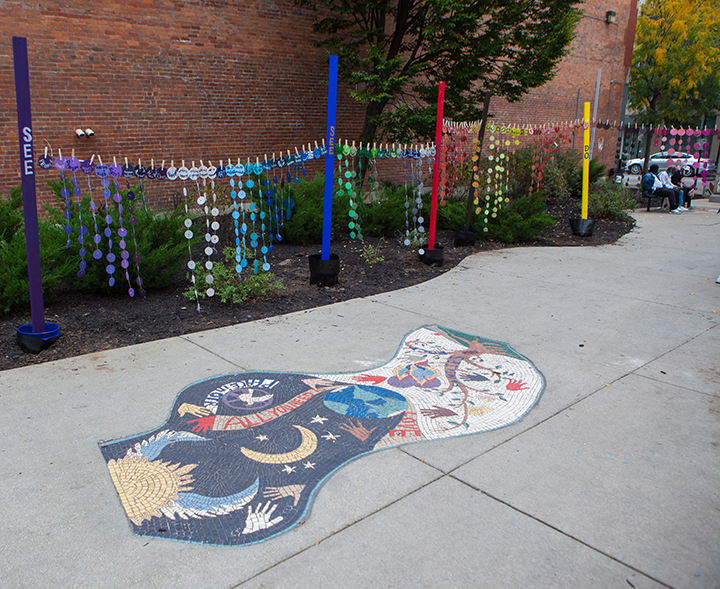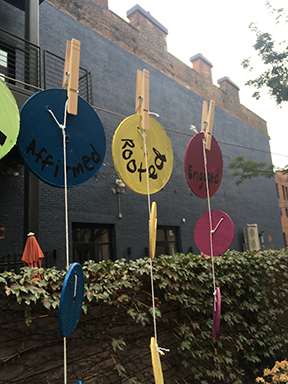Miami University ARC + ID Students Facilitate a Shared Vision for Imagination Alley


Imagination Alley in Over-the-Rhine in Cincinnati, OH.
Miami University students in the Architecture and Interior Design Department joined the Storefronts community arts team from the Center for Community Engagement in Over-the-Rhine to learn what the community wants to see in "Imagination Alley." The space is a public park and pathway, in the Over-the-Rhine neighborhood and is home to a mosaic art project completed in the early 2000’s.
Since 2002, the Miami University Center for Community Engagement (MUCCE) has established collaborations between Miami University and community groups in Over-the Rhine. Based on the Center's long-term relationship with the Over-the-Rhine People's Movement, the Center has developed four practices: Design/Build, Agit-Props, Community Assistance, and Community Advocacy. All focus on promoting democratic, equitable development strategies for low-income workers, families, and people of color. The Storefronts projects grew from the tradition of “agit-props”-- installations and engagement events first initiated by MUCCE founder Professor Tom Dutton’s architecture studios, using art to bring attention to community issues. Since 2017, the Storefronts events have been facilitated by MUCCE Director John Blake and artist Mary Clare Rietz and driven by the Storefronts Team, eight people who live in-- and love-- Over-the-Rhine.
Storefronts' success attracted the attention of Cincinnati Center City Development Corporation ( (3CDC), which plans to redevelop Imagination Alley over the next several months. 3CDC turned to the Storefronts team to help them discover what the community wants to see in the park. One Storefronts team member and Over-the-Rhine resident, Key Beck, shared their hopes for Imagination Alley to become a place of safety, inclusion, and community for every resident, "I think this space can show how community engagement can help improve projects and processes. I want it to be the rainbow of the neighborhood. I want Imagination Alley to be a place for people of all ages, races/ethnicities, income level, housing status, etc. A place for everyone." The Storefronts team set up in the park throughout several weekends and weekdays, distanced, to gather people's input. "We were not there to find a solution, we were there to create a place to question the problem," shared John Blake, Director of MUCCE. "There are a lot of different forces and cultures in one place; we were there to ask how you make sure everyone is heard."
The Storefronts Team conducted surveys that asked community members questions about what they wanted to see, feel, hear, taste, smell, and do in the park and share any concerns. The group found that community members were passionate about the park and its future. Architecture student Jackson Rastetter, who participated in John Blake’s design studio that helped to facilitate the Storefronts team’s work, said that they "were most surprised to see how much community members enjoy Imagination Alley. People in Over-the-Rhine love the area and care deeply about the future of it." Once the surveys were collected, the team had the challenge of sharing that data with both the community and project stakeholders in a creative and meaningful way.
 Miami Students at the Oxford Campus color-coded the responses and created 1,000 vibrant wooden discs to match. Posts were installed in the park, and the responses were hung in a clothesline fashion under corresponding categories. Bachelor of Arts in Architecture student Alyssa Fernbach said that "the in-depth conversations about bridging the divide between rural communities and the city will affect my future endeavors as an architect. I am thankful for the opportunity and look forward to seeing what the future brings for Imagination Alley." The community's values and voices were visually represented and displayed to create a shared experience for both community members and visitors, including 3CDC.
Miami Students at the Oxford Campus color-coded the responses and created 1,000 vibrant wooden discs to match. Posts were installed in the park, and the responses were hung in a clothesline fashion under corresponding categories. Bachelor of Arts in Architecture student Alyssa Fernbach said that "the in-depth conversations about bridging the divide between rural communities and the city will affect my future endeavors as an architect. I am thankful for the opportunity and look forward to seeing what the future brings for Imagination Alley." The community's values and voices were visually represented and displayed to create a shared experience for both community members and visitors, including 3CDC.
The Storefronts Team and students presented their findings to the landscape architect on October 13, followed by the Over-the-Rhine Community Council on October 26. The team also created a final report and video about the project. The final design scheme will be brought in front of the Storefronts Team for endorsement. This exciting method of collecting and presenting data along with the community helped discover what people want to experience or how they want to feel in the space. Incorporating the findings into the final design solution will get community members involved and excited about the future of Imagination Alley. Anna Hendryx, who participated in the project as a Bachelor of Art student in Architecture, added, "If Imagination Alley is a space for community, I hope that it remains a space where the community can be felt by those who need it most."

